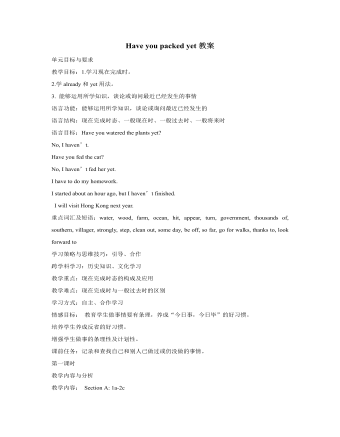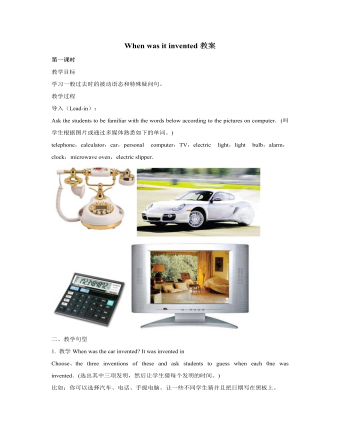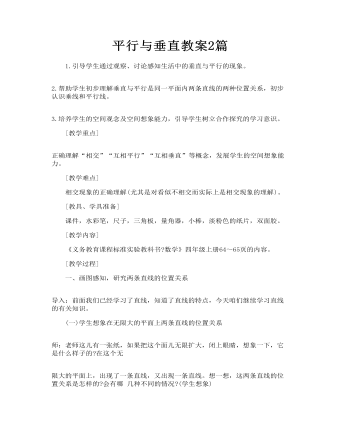人教版新目标初中英语九年级下册Could you please tell me where the restrooms are教案
-
- 页数:14页
- 字数:约 19608 字
- 大小:99.00KB
- 格式:.doc
- 版本:Office2016及以上版本
- 作者:尹超工作室
Could you please tell me where the restrooms are教案
The First Period
Ⅰ. Teaching Aims and Demands
1. KnowledgeObjects
(1) Key Vocabulary
restroom,shampoo, stamp
(2) Target Language

Excuse me. Can you pleasetell me where I can get a dictionary?
Sure. There’s a bookstoreon River Road.
2. AbilityObjects
(1)Train students listening ability.
(2)Train students communicative competence.
3. Moral Object
Helping each other is very important. It is a goodquality.
Ⅱ. Teaching Key Point
Target Language
Ⅲ. Teaching Difficult Points
1. How to train students listening ability.
2. How to train students communicative competence.
Ⅳ. Teaching Procedures
Step Ⅰ Revision
T: You’re new to thisschool. You need to know where the main office
is.How can you askwhere the main office is?
S1: Where’s themain office?
T: That’s one way toask. But there is a more polite way you can ask. You
can say,"Can you tell me where the main office is?" Class repeat. Can you
tell me wherethe main office is?
Ss: Can youtell me where the main office is?
T: That’s correct. Now let’s say you wantto know where Classroom 1 is.
How can youask?
S2: Can youtell me where Classroom 1 is?
T: Good!There’s another polite way you can ask: Could you tell me how to
get toClassroom 1? Class repeat. Could you tell me how to get to
Classroom 1?
Ss: Could youtell me how to get to Classroom 1?
T: That’s right. Very good.
Step Ⅱ 1a
Go through theinstructions with the class.
Read the listof things to the class. To review the meaning of each item
on the list,invite different students to say each phrase in their own
words.
Point to thelettered parts of the picture one by one.
Ask a student:What kind of place is this?
What do theysell there? Do we have one in our community? What is the name
of the one inour community?
Point out thesample answer. Say, The letter c is in front of the words
buy shampoobecause you could buy shampoo in a department store. There may
be more thanone correct answer for some blanks.
While studentsare working, move around the room offering help as
necessary.
Step Ⅲ 1b
Read theinstructions to students. Point out the two conversations that
are shown inthe picture.
As you listen,fill in the blanks with words you hear in the recording.
Play therecording the first time.Students only listen.
Play therecording a second time.This time ask them to fill in the blanks
with the wordsyou hear.
Check theanswers with the whole class.
Step Ⅳ 1c
Read theinstructions to the class.
Point out thelist of things people need and the pictures of the places in
activity 1a. Say. Look atactivity la. Have a conversation with a partner.
Ask your partner politelywhere you can do these thing and then answer your
partner’s questions.
As studentswork, listen to some pairs in order to check the progress and
help withpronunciation as needed.
After studentshave had a chance to practise several exchanges, ask some
pairs to cometo the front of the classroom and act out their
conversations.
Step Ⅴ Homework
Review thetarget language.
The Second Period
Ⅰ. Teaching Aims and Demands
1. KnowledgeObjects
(1) Key Vocabulary
escalator,furniture, exchange money, elevator
(2) Target Language
Excuse me. Do you knowwhere I can exchange money?
Sure. There’s a bank on thesecond
floor. Take theescalator to the second floor and turn right. The bank is
next to thebookstore.
2. AbilityObjects
(1)Train students listening ability.
(2)Train students communicative competence.
3. Moral Objects
If someone asksyou how to get to the place he wants to go to, you should
tell him theway correctly.
Ⅱ. Teaching Key Points
1. Key Vocabulary
exchange money
2. TargetLanguage
Excuse me. Do you know where I can exchangemoney?
Sure. There’s a bank on the second floor.
3. Structures
Do you know where I can buy shampoo?
Could you tell me how to get to the postoffice?
Can you please tell me where I can get adictionary?
Ⅲ. Teaching Difficult Points
1. Indirectquestions.
2. How to improvestudents listening ability.
Ⅳ.Teaching Procedures
Step Ⅰ Revision
Check homework.
Step Ⅱ 2a
Read theinstructions and point to the list of directions.
Get students toname the items in the picture such as escalator, elevator,
shoe store, andso on.
Play therecording. Students only listen.
Tell them thatthe picture may help them understand what they are hearing.
Play therecording again. This time ask students to write a number next to
four of thedirections.
Check theanswers with the whole class.
Step Ⅲ 2b
Point to thepicture. Say, now you will hear the recording again. This
time show wherethe boy went as he followed the directions to the drug
store. Draw a line onthe picture in your book.
Play therecording again and ask students to draw the line on their own.
Check theanswer with the class.
Step Ⅳ 2c
Ask a pair ofstudents to read the sample conversation aloud to the class.
Read theinstructions aloud. Say. Make conversations using information
about theplaces in the picture with your partners.
As studentswork, move around the classroom checking the progress of the
pairs andoffering help as needed.
Ask one or twopairs to say their conversations to the class. Ask the rest
of the class tolook at the picture as they listen.
Step Ⅴ Homework
Ask thestudents to write three sentences with the starters of the
structures.
The Third Period
Ⅰ. Teaching Aims and Demands
1. KnowledgeObjects
(1) Key Vocabulary
hang out,fresh, advantage, disadvantage, block
(2)Target Language
Go out thefront door and take a right. Walk about three blocks. Go past
the park, andturn left onto Oak Street.
3. Moral Objects
Anything hasboth advantages and disadvantages. We should treat everything
correctly.
Ⅱ. Teaching Key Point
Train students listening, speaking, reading and writing ability.
Ⅲ. Teaching Difficult Points
How to improve students integrating skills.
Ⅳ. Teaching Procedures
Step Ⅰ Revision
T: Yesterday welearned the structures.
Do you knowwhere…? Could you tell me how to get to…? Can you please tell
me where…? Nowwho can make sentences by using the structures?
Step Ⅱ 3a
Read theinstructions. Point out the blank lines under the words
Advantages andDisadvantages below the interview.
You will writeyour answers in these blanks.
Read the firsttwo sentences at the top of the article.
Explain thatthe interviewer will talk to several teenagers.
Get students toread the interview on their own quickly.
When they havefinished, ask if there are any words or sentences they don’t understand. If there are,explain them.
Ask students toread the interview again and write the advantages and disadvantages. Check theanswers with the whole class.
Step Ⅲ 3b
Read theinstructions. Point out the conversation in the box and invite two students toread it to the class.
Point out thelist of advantages and disadvantages in Activity 3a. Say,
You can usethese items and any other items you can think of as you talk about places youusually hang out.
Ask students towork in groups of four or five. As they work, move around the classroom helping the groups asnecessary. Make sure they talk about both advantages and disadvantages.
Ask severalgroups to act out part of their conversation to the class.
Step Ⅳ 4
Read theinstructions to the class. Get students to look back at the picture and activities on thefirst page of this unit.
Point out thesample language in the box. Invite a student to read it to the class.
Ask students tosay the names of some stores and other places in the community and write themon the board. Say,
Each group canchoose three of these places to write about, or you can choose another placeyou know ofWrite careful directions from the school to each place, but donot say the name of the place. You can use the words this place instead. In order to helpstudents work, draw a simple map showing the school and several nearby streets.
When the groupsare ready, they read their directions to the class and the other students guessthe name of the place they are talking about.
Step Ⅴ Homework
1. Ask studentsto choose two places in the community and write careful directions from theschool to each place.
2. Finish off theexercises on pages 46~47 of the workbook.
The Fourth Period
Ⅰ. Teaching Aims and Demands
1. KnowledgeObjects
(1)Key Vocabulary
fascinating,convenient, safe, restroom, inexpensive
(2)Target Language
Can you tell mewhere there’s a good place to eat?
Of course. What kind offood do you like?
2. AbilityObjects
(1) Train students writing and speaking ability.
(2) Train students ability to understand the targetlanguage in spoken conversation.
(3) Train students ability to use the target language.
Ⅱ. Teaching Key Points
1. Key Vocabulary
convenient, safe, restroom inexpensive
2. TargetLanguage
Can you tell me where there’s a good place toeat?
Of course. What kind of food do you like?
Ⅲ. Teaching Difficult Points
1. How to improvestudents writing and speaking ability.
2. How to use thetarget language.
Ⅳ. Teaching Procedures
Step Ⅰ Revision
Check homework.
Step Ⅱ 1a
Go through theinstructions with the class.
Read the wordsin the box to the class and ask if there are any of these words that studentsdon’t understand. If so, help students to explain the meaning of the word.
Then read theinstructions again and point out the sample answer. Get a studentto read the sample answer to the class. Point out that students can also writeother words after the word clean.
Ask students towrite words from the box in the blanks on their own. Help studentsif needed.
Correct theanswers by having students read what qualities he or she listed.
Step Ⅲ 1b
Read the instructionsto the class.
Point out theexample in the box. Invite two students to read it to the class.
Now work with apartner. Look at the words in the box and use them to talk about places inyour own city. As students talk, move around the classroom checking their work. Offer languagesupport as needed.
Invite severalpairs of students to say their conversations to the class.
Step Ⅳ 2a
Point to thepicture and ask students to tell what is happening. If necessary,explain that the scene shows a family on vacation. They are asking the man forinformation about various things to do in Sunville.
Go through theinstructions and point to the chart.
Play therecording. Students only listen the first time.
Play therecording again. Ask students to write the places people ask about.
Check theanswers with the whole class.
Step Ⅴ 2b
Read theinstructions and point to the chart.You will hear the same recording again.
This timelisten carefully to the answers the clock gives. Write the answers in the blanks alone.Point out thesample answer.Play the recording again. Ask students to write their answers inthe blanks.Check the answers.
Step Ⅵ 2c
Point to thesample conversation. Invite two students to read it to the class.Read theinstructions. Role play the conversations you hear on the tape.Get students towork in pairs. Move around the room checking the progress of the pairs andoffering help as needed.
Ask one or twopairs to say their conversations to the class.
Step ⅦHomework
Talk about someplaces using the words in la, then write down the conversations.
The FifthPeriod
Ⅰ. Teaching Aims and Demands
1. Knowledge Objects
(1) Key Vocabulary
water slide,clown, dress up, have fun
(2) Practise reading an article.
(3) Practise writing something using thetarget language.
2. AbilityObjects
(1) Train students reading ability.
(2) Train students writing ability.
Ⅱ. Teaching Key Point
Practisereading and writing using the target language.
Ⅲ. Teaching Difficult Point
How to write aguide to a place.
Ⅳ. Teaching Procedures
Step I Revision
Review thetarget language presented in this unit. Check homework.
Step Ⅱ 3a
Invite a studentto read the article aloud to the class. Correct any pronunciation errors tomake sure the student is providing a good model for the rest of the class.
Ask students toread the article again and complete the chart. Get students to do the work on theirown or in pairs. As they work, move around the classroom and offer help asnecessary. Check the answers.
Step m 3b
Read theinstructions to the class. Point to the first two sentences and ask a student to readthese sentences to the class.
Look back at Activities2a and 2b. Use this information to help you complete the guide to Sunville.
Ask thestudents to complete the brochure on their own. As they work, walk around theclassroom offering help and answering questions as needed.Invite astudent to read the completed article to the class.
Step Ⅳ 3c
Read theinstructions to the class.Ask students to say the names of some of the places they mightwrite about. Write a list of these places on the board forstudents to use as they write their guides.Ask students to work on their own. Tell them thatthey can use what they wrote
for activity 3bas a guide. They can write the guide for all tourists, teenagers, families,or people on a budget. As they work, move around the room offering help as needed. Correct the students work. Ask some students to read their guides and correct them.
Step Ⅴ Part 4
Go through theinstructions with the class.Get students to look back at the guides they wrote in Activity3c.Ask students to work in groups of four or five students. Let differentstudents play the role of the booth worker and the different tourists. Make sureevery student has a chance to participate.Ask one or two groups to say one oftheir conversations to the class.
Step Ⅵ Homework
1. Read thearticle in 3a again.
2. Write a guideto our city.
The Sixth Period
Ⅰ. Teaching Aims and Demands
1. KnowledgeObjects
(1) Fill in blanks and make sentencesusing beautiful, safe, delicious, convenient, fascinating.
(2)Write some questions using the targetlanguage.
2. Ability Objects
Train students writing ability.
Ⅱ. Teaching Key Points
1. Fill in blanksand make sentences.
2. Writequestions using the target language.
Ⅲ. Teaching Difficult Point
Make sentencesusing "beautiful, safe, delicious, convenient, fascinating".
Ⅳ.Teaching Procedures
您可能喜欢的文档
查看更多
人教版新目标初中英语九年级下册Have you packed yet教案
- 页数:24页
- |大小:103.00KB

人教版新目标初中英语九年级下册Rainy days make me sad教案
- 页数:12页
- |大小:559.00KB

人教版新目标初中英语九年级下册When was it invented教案
- 页数:12页
- |大小:586.50KB

人教版新目标初中英语九年级下册By the time I got outside, the bus had already left教案
- 页数:38页
- |大小:208.50KB

人教版新目标初中英语九年级下册You’re supposed to shake hands教案
- 页数:9页
- |大小:59.50KB

人教版新目标初中英语九年级下册I’ll help clean up the city parks教案
- 页数:13页
- |大小:547.50KB
热门课件教案

平行与垂直教案2篇
- 页数:9页
- |大小:101.04KB
- 课件教案

部编版语文八年级下册《马说》教案
- 页数:8页
- |大小:367.50KB
- 课件教案

部编版语文八年级下册《时间的脚印》教案
- 页数:4页
- |大小:511.50KB
- 课件教案

部编版语文八年级下册《社戏》教案
- 页数:8页
- |大小:340.00KB
- 课件教案

精选高中生期末评语
- 页数:42页
- |大小:7M
- 课件教案

人教版高中语文《小狗包弟》教案
- 页数:8页
- |大小:29.21KB
- 课件教案
今日更新

精选高中生期末评语
- 页数:42页
- |大小:7M

××县招商局2024年上半年工作总结
- 页数:12页
- |大小:142.54KB

“四零”承诺服务创建工作总结
- 页数:5页
- |大小:39.83KB

“改作风、提效能”专项行动工作总结
- 页数:6页
- |大小:139.05KB

“大学习、大讨论、大调研”活动情况总结报告
- 页数:7页
- |大小:26.12KB

2024年度工作计划汇编(18篇)
- 页数:72页
- |大小:196.93KB






